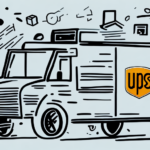Understanding UPS Insurance
UPS insurance serves as a protection plan for the goods you ship using UPS services, safeguarding against potential damages or losses that may occur during transit. This insurance is applicable for both domestic and international shipments and can be purchased directly through UPS.
What is UPS Insurance?
UPS insurance covers the cost of goods shipped by UPS in the event of damage or loss. Coverage options range from $100 to $50,000 per package, depending on the destination and type of shipment. Additionally, UPS offers services like declared value and signature confirmation to enhance package protection.
It's crucial to note that UPS insurance excludes certain items such as cash, jewelry, and antiques. Reviewing the terms and conditions of the insurance policy is recommended to ensure comprehensive coverage for your shipments.
The Basics of UPS Insurance Coverage
For shipments valued under $100, UPS includes automatic coverage in the shipping cost. For higher-value packages, additional insurance must be purchased, with maximum coverage amounts reaching $50,000 per package or $100,000 per pallet.
UPS insurance covers the value of the package or pallet but does not extend to consequential or indirect losses. Items like antiques, artwork, and jewelry may require additional documentation or appraisal to qualify for coverage.
Assessing Your Shipping Needs
Understanding Your Shipping Needs
Before opting for UPS insurance, evaluate the value of your shipment and the risk of damage or loss during transit. High-value or fragile items may justify the investment in insurance, while lower-risk goods might not require it.
Consider the shipment's destination as well. Domestic shipments generally carry a lower risk compared to international ones. Additionally, if shipping to areas with a history of theft or damage, insurance becomes more valuable.
How to Determine the Value of Your Shipment
Assess the total value of your shipment, including the item's cost and any potential repair or replacement expenses. For instance, if shipping an item valued at $500 with replacement costs around $1,000, purchasing insurance is advisable.
Don't overlook the sentimental value of items. Irreplaceable or emotionally significant items warrant insurance to ensure their protection during shipping.
Also, evaluate the shipping method. Fragile items or shipping methods with higher damage risks may necessitate insurance, even for items with moderate value.
Evaluating UPS Insurance: Pros and Cons
The Pros of UPS Insurance
- Peace of Mind: Knowing your shipments are protected against loss or damage provides security for business owners.
- Customer Trust: Offering insured shipping builds trust with customers who expect safe and timely deliveries.
The Cons of UPS Insurance
- Additional Costs: Insurance premiums can accumulate, impacting profit margins, especially for businesses frequently shipping high-value items.
- Coverage Limitations: Certain items, like jewelry or antiques, may require separate insurance or might not be covered at all under UPS insurance policies.
The Cost of UPS Insurance vs. the Cost of a Lost Shipment
While insurance premiums represent an extra expense, the financial impact of a lost or damaged shipment can be significantly higher. Without insurance, businesses bear the full cost of replacing or repairing lost items.
UPS insurance costs vary based on shipment value and desired coverage level. Businesses often negotiate better rates by committing to exclusive shipping with UPS or bundling insurance with other services.
Beyond financial protection, UPS insurance enhances business credibility by assuring customers that their shipments are safeguarded, thereby boosting trust and reputation.
Handling Lost or Damaged Packages
What Happens if a Package is Lost or Damaged in Transit?
If a package is lost or damaged during transit, the process for filing a claim depends on the type of insurance purchased. Typically, UPS requires documentation of the shipment's value, evidence of damage or loss, and proof of delivery.
It's advisable to research and compare different carriers' insurance policies before selecting a shipping option. Proper packaging and labeling can also minimize the risk of damage or loss during transit.
How to File a Claim with UPS for a Lost or Damaged Package
To file a claim with UPS for a lost or damaged package, initiate the process online through the UPS website. After filing, UPS may request additional documentation or evidence to process the claim.
Be aware of UPS's specific time limits for filing claims: within 60 days for lost packages and within 9 months for damaged packages. Filing claims promptly ensures a quicker resolution.
Exploring Alternatives to UPS Insurance
Third-Party Shipping Insurance Options
In addition to UPS insurance, several third-party shipping insurance providers offer similar or even enhanced coverage options. These alternatives often provide more flexible terms and competitive premiums.
For example, FedEx Insurance offers comprehensive coverage for various shipment types. Another option is USPS Insurance, which provides competitive rates for both domestic and international shipments.
When to Use Third-Party Shipping Insurance
Third-party shipping insurance can be advantageous for businesses that consistently ship high-value or fragile items requiring specialized coverage. These providers often exceed the standard coverage offered by carriers like UPS.
International shipments can benefit from third-party insurance, as different countries have varying shipping regulations and restrictions. Tailored coverage ensures protection across diverse regions.
Additionally, consolidating shipping and insurance services with a single third-party provider can streamline operations and reduce overall shipping costs, benefiting small businesses or those with limited resources.
Best Practices for Protecting Your Shipments
While insurance offers a safety net, proactive steps can significantly reduce the risk of shipment issues:
- Proper Packaging: Use sturdy packaging materials and appropriate cushioning to protect items from damage.
- Clear Labeling: Ensure packages are labeled correctly with accurate delivery addresses and handling instructions.
- Tracking Shipments: Utilize tracking services to monitor the progress of your shipments and address any issues promptly.
Conclusion: Is UPS Insurance Worth It for Your Business?
Deciding whether to purchase UPS insurance hinges on your business's specific needs and risk factors. For companies that frequently ship high-value or fragile items, UPS insurance can be a valuable investment, providing financial protection and enhancing customer trust.
Conversely, for businesses with lower-risk shipments, the additional cost of insurance may not be justifiable. Weigh the pros and cons, assess your shipping requirements, and explore alternative insurance options to make an informed decision that aligns with your business objectives.






















